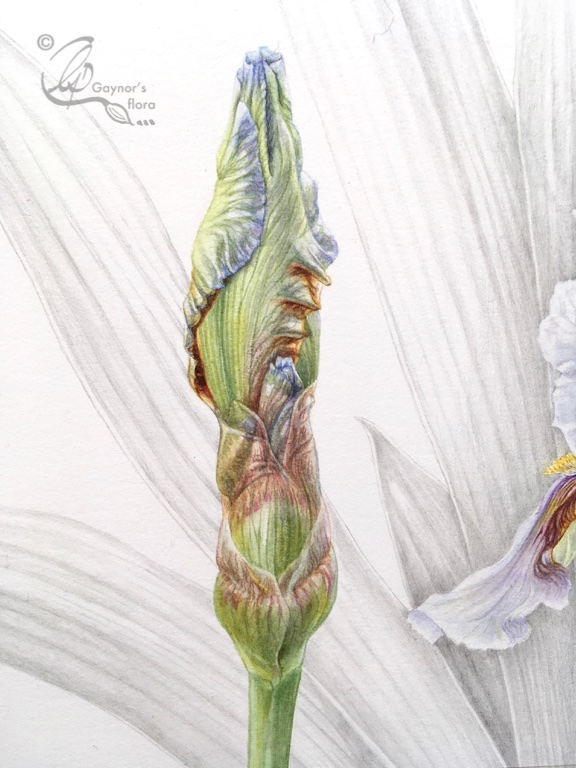
Five years ago, on 17 November 2016, four botanical artists and a husband held our first meeting, in Newport Pagnell. We had an agenda and an idea for a name, the Association of British Botanical Artists. ( ABBA ). The name is still going strong, and ABBA has steadily grown stronger.
Shevaun Doherty, Dianne Sutherland and me, Gaynor Dickeson were at the American Society of Botanical art (ASBA) conference in Pittsburgh in October 2016. There we learned that no UK Society or group had plans for the UK to take part in Botanical Art Worldwide, to be held, as its name suggests, worldwide, on 18 May 2018, only 18 months away.
Clearly the UK would not be represented unless we stood up and did something. We decided to get together again once back in England and see what we could do at such short notice. Scotland and Ireland had declared independence and each went on to do its own thing.
On Thursday 17 November, the three of us combined the botanical art pleasure of a visit to William Cowley, the only UK firm still making traditional vellum at its factory in Newport Pagnell, with a serious meeting in a nearby Polish restaurant to talk about the following year’s worldwide botanical art exhibition.
I had put together an agenda. Sarah Morrish came with us to visit Cowleys and agreed to join the group for our meeting. Shevaun was part of the Irish contingent that would have its own exhibition, so after this initial brainstorming she helped Ireland do its own thing too.
We discussed forming an organisation to represent England, Wales and Northern Ireland. And decided to give both the new organisation (ABBA) and its exhibition a good go. We realised that time was against us and that we couldn’t manage it completely on our own.
The agenda touched on many of the issues we were likely to find and would need to overcome, from a time line, to people who might like to become involved, to financing, where to exhibit etc, etc………..!
This left Dianne, Sarah and me, plus Robin my husband. As usual, he had a notebook and took the notes that became the minutes. While with me in Pittsburgh, he’d thought up the ABBA name.
Sarah and I lived relatively near to each other, so with me co-ordinating the whole, we agreed to share the workload. Dianne had ideas about where we could exhibit and followed up on that.
We left the meeting with an agreed name for the new organisation, minutes and lists of immediate jobs that needed doing and with jobs delegated.
The meeting itself did get our juices going and already at that point we thought ‘what if…’ could we create something that might continue after the exhibition?
We were very enthusiastic and determined that England would not be left out of so important an event.
Between us we put in many hours to get to the first stage in our timeline, launching a website in time for the Royal Horticultural Society’s (RHS) 2017 botanical art exhibition held in London in the February.


ABBA launch RHS 2017
We used the RHS exhibition as an opportunity to tell as many botanical artists as possible about Botanical Art Worldwide and tell them how they could participate in this truly unique event.

The judges; Helen Allen, Brent Elliot, Christabel King, Martyn Rix, Ann Swan 
The rest of the team for the final judging day;
Christabel King, Deborah Lambkin, Sarah Morrish, Gaynor Dickeson, Lucy Smith
We went on to gather a brilliant team, many of whom needed to work extremely hard for those 18 months. The result was Botanical Art Worldwide; In Ruskin’s Footsteps. This very professional exhibition, at the Peter Scott Gallery, Lancaster University, was England’s contribution to the unique, Botanical Art Worldwide, on Friday 18 May 2018.

Opening, ‘In Ruskin’s Footsteps.
Gaynor Dickeson, Martin Allen, Sarah Morrish
Some of the artists at the opening of ‘In Ruskin’s Footsteps’ 
Martin Allen talking about the artwork exhibited. 
Opening day – studying the artwork 
The late Mally Francis demonstrating her artistic skills 18 May 2018
Additionally, we were able to involve the Shirley Sherwood Gallery, Royal Botanic Gardens, Kew, Royal Horticultural Society’s Lindley Library in Westminster and Chelsea Physic Garden, London as ‘partnership exhibitions’ held at the same time.
A unique element of Botanical Art Worldwide was the slide show combining 40 pictures from each of the 25 participating countries, displayed simultaneously round the world 18 May 2018. In England the 900 plus pictures were displayed throughout ‘In Ruskin’s Footsteps’ as well as the ‘partnership’ exhibitions.
The exhibition in Lancaster was the reason we started ABBA. We were determined that England should be represented in that first worldwide exhibition.
As we worked to organise the Lancaster exhibition, we found that lots of botanical artists wanted to see ABBA continue.
During that 2017 RHS exhibition Elaine Allison had introduced herself and her husband Alan; they had fairly recently arrived from Australia. They too were enthusiastic about ABBA and wanted to get involved.
After the Botanical Art World-wide, in Ruskin’s Footsteps, both Elaine and Alan got seriously involved with ABBA, as did Martin Allen. They have played an increasingly vital role in the development of the organisation as you see it today.
The final team that worked hard until the last day of the exhibition were:
- Martin Allen
- Elaine Allison
- Gaynor Dickeson
- Robin Dickeson
- Deborah Lambkin
- Sarah Morrish
- Adrienne Roberts
- Lucy Smith
- Claire Ward
Congratulations and well done all, it was worth all the effort.









































